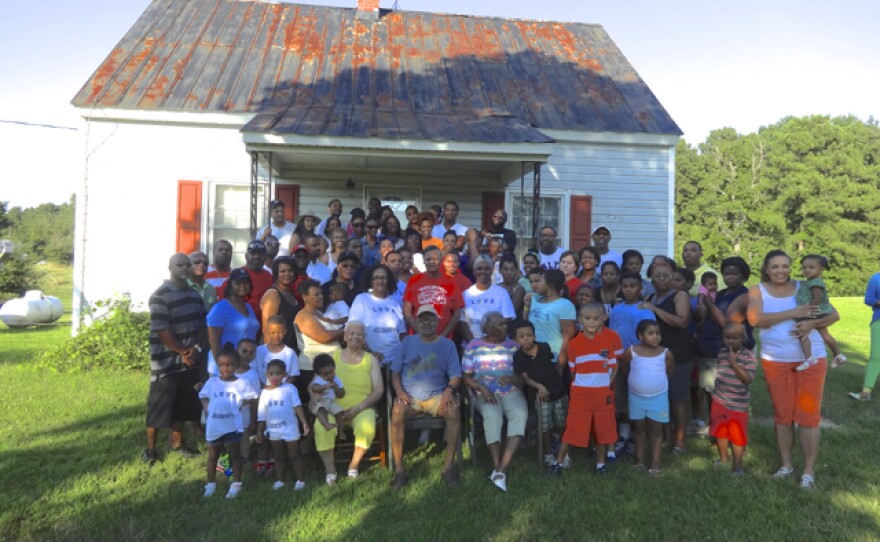By: Jordan Meadows
Staff Writer
The Landis family of Creedmoor, North Carolina, long celebrated in the two-part documentary series A Singing Stream, represents one of the most remarkable family histories in the state—an intergenerational story shaped by land, labor, and a musical tradition passed down like an heirloom.
The family story begins with matriarch Bertha Mangum Landis, born in 1898—the same year as the Wilmington Race Riot. Her lifetime would span Reconstruction’s aftermath, the rise of segregation, the Great Depression, the New Deal, the civil rights era, and into the new millennium. Through each chapter, Bertha became the steady center of a sprawling family that would eventually grow from 11 children to nearly 100 descendants.
Her early years were steeped in music. Bertha came from a lineage of shape-note singers, teachers, and church leaders, and she recognized that the man she married, young farmer Coy Landis, also carried what she called “the singing stream.” She passed that legacy directly to their children—eight boys and three girls—by teaching them parts and harmonies at home. While Coy sometimes attempted to silence late-night singing from the rooms overhead, Bertha defended the racket: “Don’t get after them,” she would say. “They may be great musicians someday.”
And they were. The Landis children grew into one of the region’s most beloved gospel lineages, with several of the sons forming the acclaimed quartet The Golden Echoes, known for reverent renditions of classics like “The Old Rugged Cross” and “Mighty Close to Heaven.” In church choirs, community gatherings, and stages across the state, the Echoes’ voices carried the warmth and discipline instilled by their mother.
Yet behind the music was a struggle for landownership in the Jim Crow South. For years, the Landises lived as tenant farmers, raising tobacco and vegetables for the benefit of white landowners. Coy believed they could never afford a farm of their own. But in 1938, Bertha read a newspaper article explaining that the newly created Farm Security Administration (FSA) offered loans to help poor families purchase land—and that large families were given preference.
Their application succeeded. Out of more than 300 applicants in the region, ten families—six white and four Black—were selected. The Landises were one of them. They purchased 146 acres for $1,800, after negotiating the seller down from $2,000. With financing from the FSA and a modest home built by the Godwin Company, the family moved to the Creedmoor property in 1940. For the first time, they worked the land they owned.
That land—its tobacco fields, gardens, hogs, livestock, and eventually a fish pond—became the foundation of the family’s economic independence and the physical heart of their cultural life. In Jim Crow North Carolina, the difference between stepping off the farm and stepping into town was stark. In interviews recorded for the documentary, Landis family members describe the ever-present threat of racial epithets and violence once they left the safety of their enclave. Voting rights were difficult to access, employment opportunities were limited, and harassment was routine. These pressures drove several of the children, including Fleming Landis, northward—part of a broader Black migration to cities like Akron, Ohio, where industrial jobs offered a measure of security.
Still, the farm was always home. By the 1960s, the Landises had paid off the 35-year loan in just 20 years. By the 1970s, the original acreage had evolved into a small community of houses and mobile homes owned by family members and other Black families to whom Coy sold parcels of land. When Davenport first filmed A Singing Stream in the early 1980s, four of Bertha’s children and a grandchild lived within sight of the homeplace. Bertha, then in her 80s, lived in the original farmhouse with her son Truzell, who commuted to Durham for work.
The feature-length documentary that emerged in 1985 became the only film ever made fully chronicling the history of a single African American family. It revealed a deeply grounded household where songs floated through hallways, where conversations around the kitchen table doubled as history lessons, and where faith and tradition were stitched into daily routines. The film captured scenes of barbecues, home tours, quiet laughter, and unguarded reflection.
When Davenport returned thirty years later to film A Singing Stream: Reunion, Bertha had died in 2000 at age 102, and nearly all of her children had passed. Only two—her youngest daughter, Priscilla, and her youngest son, Claude—remained. The house, worn down by time, had been restored by Claude’s daughter Lisa and her husband. New generations had moved across the country, yet the family continued to reunite on the farm every August, as they had since 1934.
Music still binds them. Fleming’s daughters—Karen and Sharon—formed the all-female gospel group Echoes of Heaven, carrying forward the harmonies their grandmother once drilled into a bedroom full of children. For scholars of African American Studies, Southern history, music, and the rural New Deal, the Landis family represents a rare and enduring case study: a Black family that not only secured land during the 1930s but held onto it across generations, turning soil into stability and stability into culture.
In Creedmoor today, the original house stands, the reunions continue, and the singing stream flows on.

